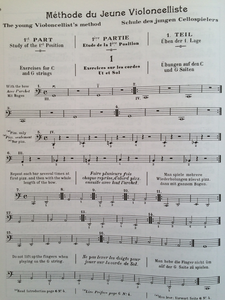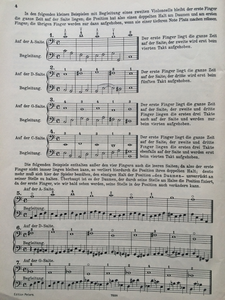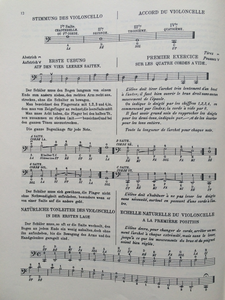2. Analysis of existing methods
a. Traditional cello methods
Before analysing the chosen Kodály inspired methods, or methods which include the development of musicianship skills, I will spend a few words on traditional cello methods, as they have been in use from the eighteenth and nineteenth century until nowadays. By this introduction I would like to describe the attitude of traditional methods towards musicianship, and the question where its training belongs. Hypothetically the difference between traditional methods and methods which include musicianship is predictable, but on the other hand, I might find similarities in teaching music in general, shared principles, by both the Kodály method and traditional cello methods.
In the eighteenth century the first cello methods started to appear throughout Europe. Michel Corrette’s “Methode théorique et pratique pour apprendre en peu de temps le violoncelle” was published in 1741, and is the first known guide for learning to play the cello (38). Subsequent methods from the nineteenth century are, among others, the methods of Piatti (1822-1901) (39), Dotzauer (1783-1860) (40), Lee (1805-1887) (41), Davidoff (1838-1889) (42), and Feuillard (1872-1941) (43).
All these early methods have a subject-logic approach, and start from a more theoretical point of view. For instance, in rhythm: they all tend to start with teaching the whole note, and then divide it into half notes, quarter notes etcetera. Melodically they start with explaining the notes and fingerings in C major, giving all notes either at once, or start from the first to the fourth finger. Again a subject-logic approach, but not at all a cello methodological approach, or a developmental approach. Feuillard even gives his reasons: “[…]and as the cello cannot be taught without the help of a teacher, we have carefully eliminated all that generally fills useless methods: that is to say: the musical theory that belongs to the teaching of solfeggio” and “Therefore, that the pupil may quickly acquire the necessary skills for playing the cello well”. (44)
In short: it is the task of a cello method to only teach the (technical) skills of playing the cello.
More recent methods, like the methods by Hirzel (1959) (45) and Längin (1974) (46) have a more cellistic-logical build-up, with short songs (sometimes even with text) and exercises in a technically logical order. But again there seems to be no intention to work on the general musical development, on the contrary: Längin states in his preface: “[...]kann man doch voraussetzen, daß ein 12-13 jähriger Schüler – nur in Ausnahmefällen wird man früher beginnen können – das Wesentliche über Noten, Notenwerte, Versetzungszeichen, Intervalle, Tonarten, Rhythmus usw. weiss, vor allem dann, wenn er sich für den Violoncello-Unterricht entscheiden hat.”
Längin clearly states the necessity to ‘know’ all the mentioned topics, especially when learning to play an instrument as the cello, but apparently he is not feeling responsible for the teaching of these.
None of the methods mentioned before does include explicitly the development of musicianship skills. It is assumed that the pupil either acquires these skills in a different lesson, or that he will be catching up along the way. However, there is a great risk that this will not happen, while the cello teaching will then probably focus mainly on finger exercises where the cellist deciphers the notation into fingering patterns, without challenging the development of listening skills. It comes down to the reduction to only teach the cello technique, considering it apart from teaching the (aural) understanding of the musical language.
The Colourstrings method, which I will look at in the b-part of this chapter, is developed by two Hungarian brothers, and is, according to my information, the first instrumental method based on the principles of Kodály. Looking at other Hungarian method books, like Antal Friss (1897-1973) “Gordonkaiskola” (47), or more recent books like Gabor Gárdián’s “Gordonkaiskola” (1992) (48) and Árpád Pejtsik “Gordonka ABC” (no date of publication, but after 1995) (49) I was expecting to find also references to Kodály. But also here I found the same features: from very subject-oriented ordering to more technical developmental ordering of the techniques on the cello, as well as an increase of pupil-friendliness. One of Kodály’s principles I recognised in Gárdián’s introduction: “[…] but I also intended to preserve the Hungarian national traditions and characteristics. I used many folk songs and the successful pieces of Hungarian composers as well as the compositions of lasting value in A. Shiffer’s and A. Friss’s tutorials.”
In the early traditional methods, the development of general musicianship skills and the development of technical virtuosity on the cello were apparently seen as two separated disciplines. The musicianship skills needed for the aural understanding of the played repertoire was trusted to be developed in other lessons.
There are some, more recent, methods, building up from well-known song repertoire, and in some of them Kodály-principles can be recognised. The method written by Benoy and Burrowes (1971) (50), bases its repertoire on folk songs, hymns and themes from classical music. The German method for children by Sassmannshaus (1976) (51) also begins with the interval ‘so-mi’, and is completely built on well-known German children’s songs, transposing them over and over again (52) to cover all the finger patterns on the cello.
There are other child-friendly method books choosing their repertoire from well-known tunes and traditionals, like the “Abracadabra” method (2002) (53), or “Superstart Cello” (2006) (54), but not as a basic principle: they combine their own compositions with well-known songs and themes. Other more recently published books offer somehow methodically ordered pieces, but cannot be used as a method without additional material. The child-friendly Cello Time Series (55) is an example of this.
Regarding this context of conventional ‘instrument-only-methods’, it is very interesting that some authors change their teaching approach and begin to develop their own methodology, incorporating the teaching of general musicianship skills. They seem to have recognised the danger of a lack of musicianship skills in instrumental playing: the perhaps virtuoso, but mechanical execution of the score, without deeper musical understanding and aural awareness of style. These authors picked up on the notion of Kodály that besides having a "well-trained hand", the true musician is also in possession of a "well-trained ear, a well-trained intelligence and a well-trained heart". (56)
Next, I will give a general description of the methods and their content, and then analyse the content according to Kodály criteria.




